David Simon's Blog, page 21
June 13, 2016
Israel Adventure - Day 5
Today started with a walk to the Caffe Yaffo. Akiva served us mini-lox sandwiches with cappuccino. The food and atmosphere were great.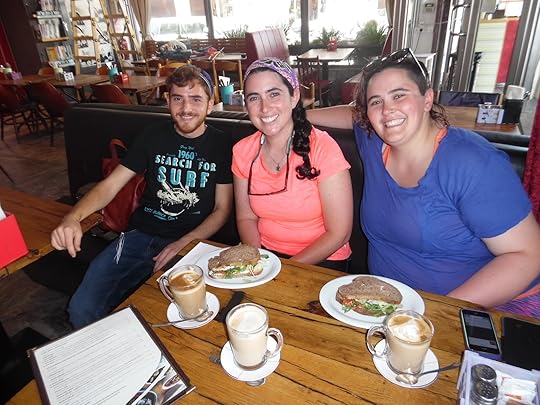 After breakfast we walked through the Jaffa Flea Market. The shops were interesting. All types of merchandise filled the stores from furniture to appliances. There were tourist items, clothing, artwork, and restaurants. Some were packed and others were well organized. The picture below shows a shop owned by a hoarder - Who knows what is there!?! We only stayed long enough to snap a picture, because that was our purpose there! Probably the owner knew where the good stuff was, but we did not … and tourists are impulse shoppers, so we moved on to the next area.
After breakfast we walked through the Jaffa Flea Market. The shops were interesting. All types of merchandise filled the stores from furniture to appliances. There were tourist items, clothing, artwork, and restaurants. Some were packed and others were well organized. The picture below shows a shop owned by a hoarder - Who knows what is there!?! We only stayed long enough to snap a picture, because that was our purpose there! Probably the owner knew where the good stuff was, but we did not … and tourists are impulse shoppers, so we moved on to the next area.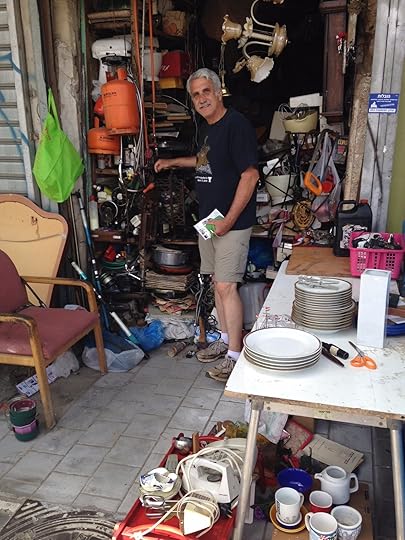 We found some interesting things in some of the other shops. I found a few items we will bring home, for which we bargained Israeli-style. Looking through the shops was an adventure. In the middle of the flea market are tents, and a huge “Yard Sale.” My mother-in-law would like that. As for us, it was cheap stuff that can be found in American thrift stores.
We found some interesting things in some of the other shops. I found a few items we will bring home, for which we bargained Israeli-style. Looking through the shops was an adventure. In the middle of the flea market are tents, and a huge “Yard Sale.” My mother-in-law would like that. As for us, it was cheap stuff that can be found in American thrift stores.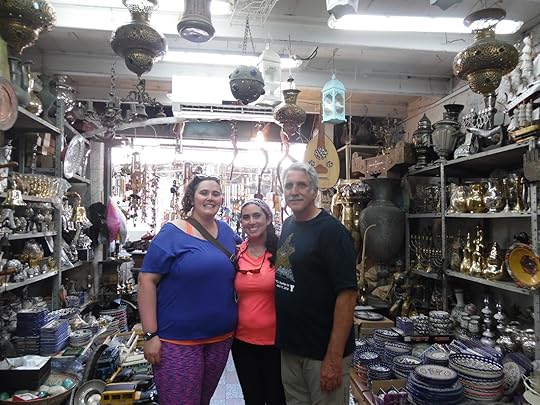 After the flea market we took the car to Machon Ayalon, an underground bullet factory operated by the Haganah. This is an interesting place and a crucial part of the War for Independence. Up above the underground factory it looked like a regular Kibbutz (collective organization for farming). The buildings were there, some of the industries were there … so the Haganah could escape British scrutiny during this intense time period.
After the flea market we took the car to Machon Ayalon, an underground bullet factory operated by the Haganah. This is an interesting place and a crucial part of the War for Independence. Up above the underground factory it looked like a regular Kibbutz (collective organization for farming). The buildings were there, some of the industries were there … so the Haganah could escape British scrutiny during this intense time period.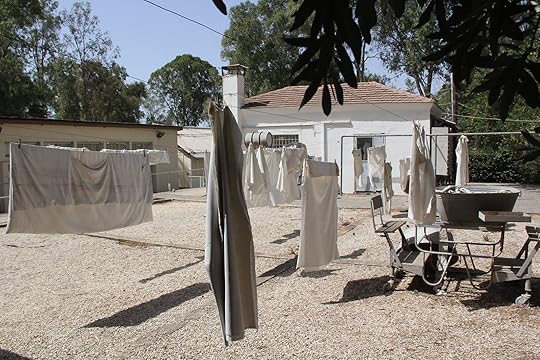 BUT, inside the laundry the Haganah had a secret - and many members of the Kibbutz had no idea what was going on right under their feet! Under the very noisy (to cover up sounds) washing machine (which moved from its “permanent place”) there was a trap door with a ladder that went down into the factory under the hill.
BUT, inside the laundry the Haganah had a secret - and many members of the Kibbutz had no idea what was going on right under their feet! Under the very noisy (to cover up sounds) washing machine (which moved from its “permanent place”) there was a trap door with a ladder that went down into the factory under the hill.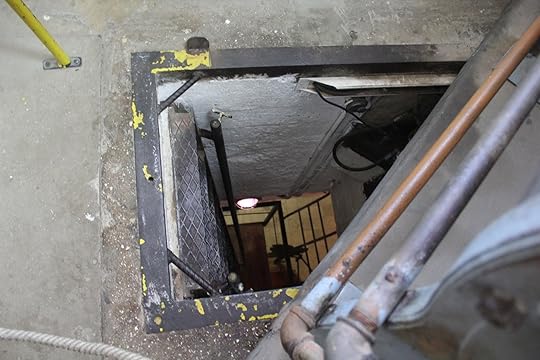 They kept the normal laundry crew in the dark by sending them out to hang clothing every time the door opened to let the 45 secret employees come up for lunch. At the end of the day they made sure the laundry workers had gone home. The mission was top secret.
They kept the normal laundry crew in the dark by sending them out to hang clothing every time the door opened to let the 45 secret employees come up for lunch. At the end of the day they made sure the laundry workers had gone home. The mission was top secret.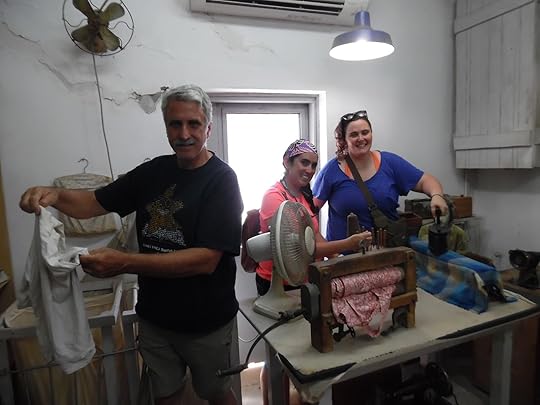 The factory was a place dug out inside the hill; inside were bullet making machines. Four and a half million bullets were produced in four years of production by 45 volunteer workers from a group of just-graduated high schoolers who, upon completion of Kibbutz training, had been recruited sans details by the Haganah for this secret mission. Two ventilation shafts gave air: The first was in the laundry, and the other shaft was at the bakery, which hid smells of manufacture with the smells of baked goods. This was a very well kept secret, which helped win the Jewish war of independence.
The factory was a place dug out inside the hill; inside were bullet making machines. Four and a half million bullets were produced in four years of production by 45 volunteer workers from a group of just-graduated high schoolers who, upon completion of Kibbutz training, had been recruited sans details by the Haganah for this secret mission. Two ventilation shafts gave air: The first was in the laundry, and the other shaft was at the bakery, which hid smells of manufacture with the smells of baked goods. This was a very well kept secret, which helped win the Jewish war of independence.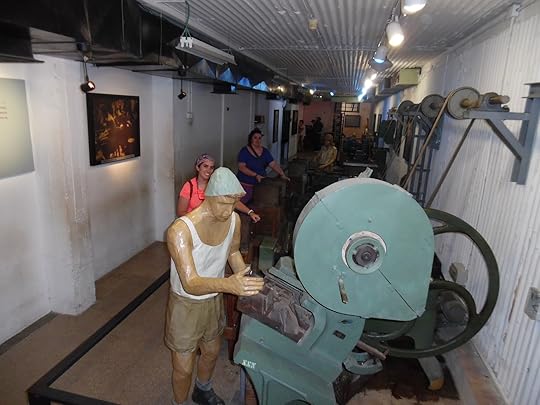 After seeing the underground bullet factory, located on Kibbutz Hill in Rehovot, we went to Yavne. This is the place the Sanhedrin of Israel moved after the Temple was destroyed in 70 AD. The Sanhedrin held the Council of Yavne where they discussed “what now.” They had a lot of issues to solve, such as how to compensate for the lack of a Temple or proper place to make sacrifices. What was to be done about the Atonement Offering? The decisions made at Yavne set the tone for the observance of Yom Kippur today. Many other decisions were made there as well.
After seeing the underground bullet factory, located on Kibbutz Hill in Rehovot, we went to Yavne. This is the place the Sanhedrin of Israel moved after the Temple was destroyed in 70 AD. The Sanhedrin held the Council of Yavne where they discussed “what now.” They had a lot of issues to solve, such as how to compensate for the lack of a Temple or proper place to make sacrifices. What was to be done about the Atonement Offering? The decisions made at Yavne set the tone for the observance of Yom Kippur today. Many other decisions were made there as well.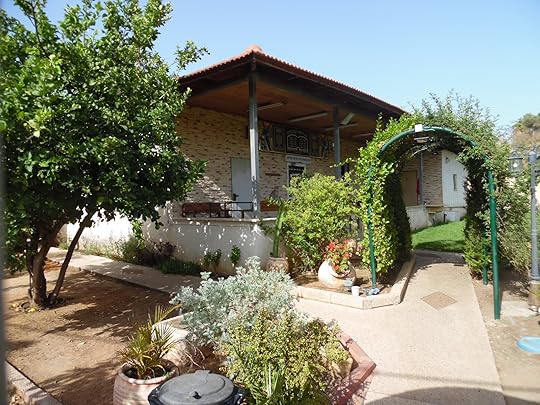 There is a tel under which the ancient ruins lie. An Ottoman tower exists on top of the tel, as does Rabban Gamaliel’s tomb (accompanied by Ali Abu Hurairah). Nothing else can be seen on the top of the hill. There is a Temple on the edge of the tel, pictured above. There is also an amphitheater on the other side of the tel, pictured below. The tower at Yavneh can be seen near the trees on the right in the background.
There is a tel under which the ancient ruins lie. An Ottoman tower exists on top of the tel, as does Rabban Gamaliel’s tomb (accompanied by Ali Abu Hurairah). Nothing else can be seen on the top of the hill. There is a Temple on the edge of the tel, pictured above. There is also an amphitheater on the other side of the tel, pictured below. The tower at Yavneh can be seen near the trees on the right in the background.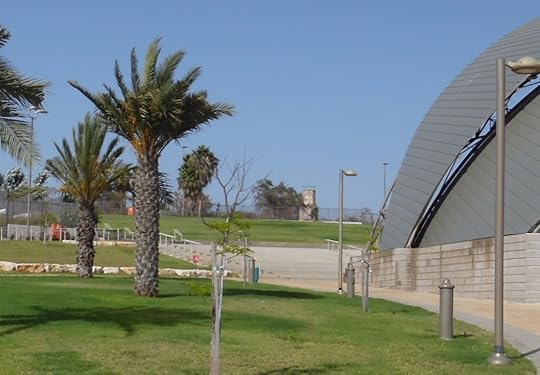 After looking at the Tel we went out to eat in Yavne. Chelsea’s Hebrew skills came in handy since the server didn’t know much English, and we survived and had a great meal, a donair with chicken and various salads.
After looking at the Tel we went out to eat in Yavne. Chelsea’s Hebrew skills came in handy since the server didn’t know much English, and we survived and had a great meal, a donair with chicken and various salads.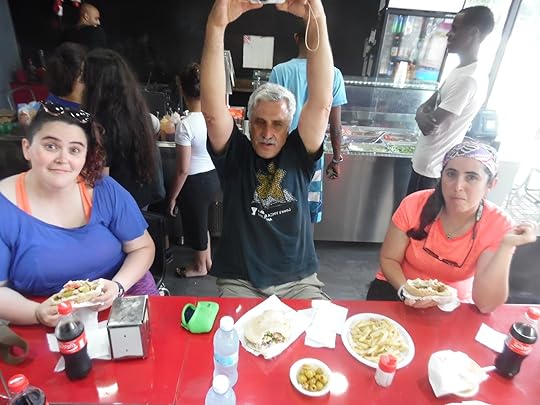 I talked to a young man there who was interested and excited that someone would come to Yavne because of the council and because Gamaliel lived there.
I talked to a young man there who was interested and excited that someone would come to Yavne because of the council and because Gamaliel lived there.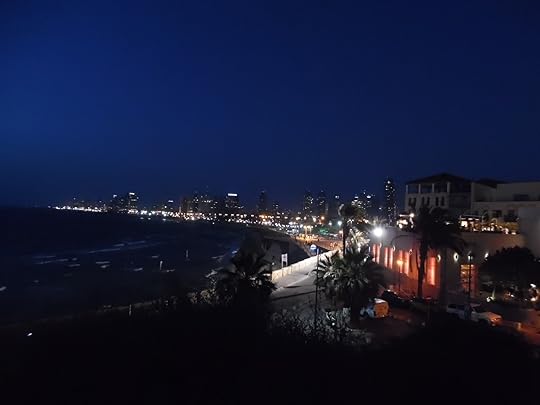 After returning to our Apartment we walked up the street to the main plaza at Jaffa. Sarah took pictures at the Zodiac Fountain. We plan to go back there tomorrow or Wednesday to see the things on the Plaza.
After returning to our Apartment we walked up the street to the main plaza at Jaffa. Sarah took pictures at the Zodiac Fountain. We plan to go back there tomorrow or Wednesday to see the things on the Plaza.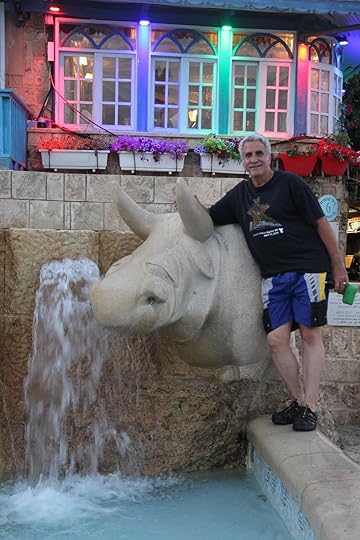 I lost my passport, a book, my kindle, and a camera in the square at Jaffa two years ago. It was either taken when I walked across the plaza to join our tour group or I hid it very well just before trying to surprise them. I asked the girls to look for the white Lechi bag, and they laughed. Chelsea said, “Why don’t you check with the Police, we filed a report.” So I went to the Police station, where I had a great visit with the officer. He said if found, it would be turned over to the US Consulate. Then we talked about Tel Gezer (he lives near there), and how we have enjoyed our visit.The police asked if I was Jewish, I answered “Yes, but I became a Christian.” He asked, “Why?” I told him that someone shared Psalm 22 with me. He asked if that was in the New Testament. I told him, “No, it is in the Tanakh.” I jotted the scripture down for him to look at when he got home.
I lost my passport, a book, my kindle, and a camera in the square at Jaffa two years ago. It was either taken when I walked across the plaza to join our tour group or I hid it very well just before trying to surprise them. I asked the girls to look for the white Lechi bag, and they laughed. Chelsea said, “Why don’t you check with the Police, we filed a report.” So I went to the Police station, where I had a great visit with the officer. He said if found, it would be turned over to the US Consulate. Then we talked about Tel Gezer (he lives near there), and how we have enjoyed our visit.The police asked if I was Jewish, I answered “Yes, but I became a Christian.” He asked, “Why?” I told him that someone shared Psalm 22 with me. He asked if that was in the New Testament. I told him, “No, it is in the Tanakh.” I jotted the scripture down for him to look at when he got home.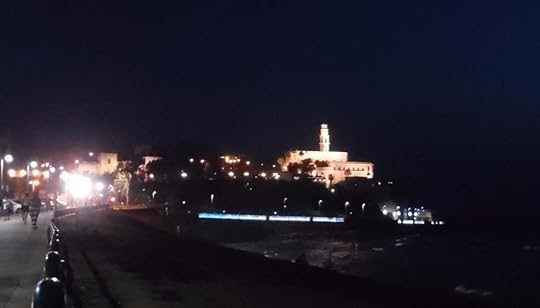 We then went down to the beach and walked along the water. We walked to Tel Aviv proper, crossed the main road, and went to an old train station (the Tachanah). We looked in some of the shops and then ate ice cream, Halva Gelato … it was good!
We then went down to the beach and walked along the water. We walked to Tel Aviv proper, crossed the main road, and went to an old train station (the Tachanah). We looked in some of the shops and then ate ice cream, Halva Gelato … it was good!
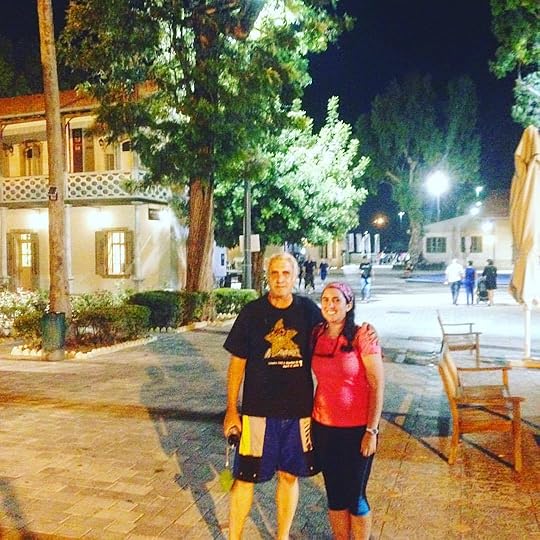
 After breakfast we walked through the Jaffa Flea Market. The shops were interesting. All types of merchandise filled the stores from furniture to appliances. There were tourist items, clothing, artwork, and restaurants. Some were packed and others were well organized. The picture below shows a shop owned by a hoarder - Who knows what is there!?! We only stayed long enough to snap a picture, because that was our purpose there! Probably the owner knew where the good stuff was, but we did not … and tourists are impulse shoppers, so we moved on to the next area.
After breakfast we walked through the Jaffa Flea Market. The shops were interesting. All types of merchandise filled the stores from furniture to appliances. There were tourist items, clothing, artwork, and restaurants. Some were packed and others were well organized. The picture below shows a shop owned by a hoarder - Who knows what is there!?! We only stayed long enough to snap a picture, because that was our purpose there! Probably the owner knew where the good stuff was, but we did not … and tourists are impulse shoppers, so we moved on to the next area. We found some interesting things in some of the other shops. I found a few items we will bring home, for which we bargained Israeli-style. Looking through the shops was an adventure. In the middle of the flea market are tents, and a huge “Yard Sale.” My mother-in-law would like that. As for us, it was cheap stuff that can be found in American thrift stores.
We found some interesting things in some of the other shops. I found a few items we will bring home, for which we bargained Israeli-style. Looking through the shops was an adventure. In the middle of the flea market are tents, and a huge “Yard Sale.” My mother-in-law would like that. As for us, it was cheap stuff that can be found in American thrift stores. After the flea market we took the car to Machon Ayalon, an underground bullet factory operated by the Haganah. This is an interesting place and a crucial part of the War for Independence. Up above the underground factory it looked like a regular Kibbutz (collective organization for farming). The buildings were there, some of the industries were there … so the Haganah could escape British scrutiny during this intense time period.
After the flea market we took the car to Machon Ayalon, an underground bullet factory operated by the Haganah. This is an interesting place and a crucial part of the War for Independence. Up above the underground factory it looked like a regular Kibbutz (collective organization for farming). The buildings were there, some of the industries were there … so the Haganah could escape British scrutiny during this intense time period. BUT, inside the laundry the Haganah had a secret - and many members of the Kibbutz had no idea what was going on right under their feet! Under the very noisy (to cover up sounds) washing machine (which moved from its “permanent place”) there was a trap door with a ladder that went down into the factory under the hill.
BUT, inside the laundry the Haganah had a secret - and many members of the Kibbutz had no idea what was going on right under their feet! Under the very noisy (to cover up sounds) washing machine (which moved from its “permanent place”) there was a trap door with a ladder that went down into the factory under the hill. They kept the normal laundry crew in the dark by sending them out to hang clothing every time the door opened to let the 45 secret employees come up for lunch. At the end of the day they made sure the laundry workers had gone home. The mission was top secret.
They kept the normal laundry crew in the dark by sending them out to hang clothing every time the door opened to let the 45 secret employees come up for lunch. At the end of the day they made sure the laundry workers had gone home. The mission was top secret. The factory was a place dug out inside the hill; inside were bullet making machines. Four and a half million bullets were produced in four years of production by 45 volunteer workers from a group of just-graduated high schoolers who, upon completion of Kibbutz training, had been recruited sans details by the Haganah for this secret mission. Two ventilation shafts gave air: The first was in the laundry, and the other shaft was at the bakery, which hid smells of manufacture with the smells of baked goods. This was a very well kept secret, which helped win the Jewish war of independence.
The factory was a place dug out inside the hill; inside were bullet making machines. Four and a half million bullets were produced in four years of production by 45 volunteer workers from a group of just-graduated high schoolers who, upon completion of Kibbutz training, had been recruited sans details by the Haganah for this secret mission. Two ventilation shafts gave air: The first was in the laundry, and the other shaft was at the bakery, which hid smells of manufacture with the smells of baked goods. This was a very well kept secret, which helped win the Jewish war of independence. After seeing the underground bullet factory, located on Kibbutz Hill in Rehovot, we went to Yavne. This is the place the Sanhedrin of Israel moved after the Temple was destroyed in 70 AD. The Sanhedrin held the Council of Yavne where they discussed “what now.” They had a lot of issues to solve, such as how to compensate for the lack of a Temple or proper place to make sacrifices. What was to be done about the Atonement Offering? The decisions made at Yavne set the tone for the observance of Yom Kippur today. Many other decisions were made there as well.
After seeing the underground bullet factory, located on Kibbutz Hill in Rehovot, we went to Yavne. This is the place the Sanhedrin of Israel moved after the Temple was destroyed in 70 AD. The Sanhedrin held the Council of Yavne where they discussed “what now.” They had a lot of issues to solve, such as how to compensate for the lack of a Temple or proper place to make sacrifices. What was to be done about the Atonement Offering? The decisions made at Yavne set the tone for the observance of Yom Kippur today. Many other decisions were made there as well. There is a tel under which the ancient ruins lie. An Ottoman tower exists on top of the tel, as does Rabban Gamaliel’s tomb (accompanied by Ali Abu Hurairah). Nothing else can be seen on the top of the hill. There is a Temple on the edge of the tel, pictured above. There is also an amphitheater on the other side of the tel, pictured below. The tower at Yavneh can be seen near the trees on the right in the background.
There is a tel under which the ancient ruins lie. An Ottoman tower exists on top of the tel, as does Rabban Gamaliel’s tomb (accompanied by Ali Abu Hurairah). Nothing else can be seen on the top of the hill. There is a Temple on the edge of the tel, pictured above. There is also an amphitheater on the other side of the tel, pictured below. The tower at Yavneh can be seen near the trees on the right in the background. After looking at the Tel we went out to eat in Yavne. Chelsea’s Hebrew skills came in handy since the server didn’t know much English, and we survived and had a great meal, a donair with chicken and various salads.
After looking at the Tel we went out to eat in Yavne. Chelsea’s Hebrew skills came in handy since the server didn’t know much English, and we survived and had a great meal, a donair with chicken and various salads. I talked to a young man there who was interested and excited that someone would come to Yavne because of the council and because Gamaliel lived there.
I talked to a young man there who was interested and excited that someone would come to Yavne because of the council and because Gamaliel lived there. After returning to our Apartment we walked up the street to the main plaza at Jaffa. Sarah took pictures at the Zodiac Fountain. We plan to go back there tomorrow or Wednesday to see the things on the Plaza.
After returning to our Apartment we walked up the street to the main plaza at Jaffa. Sarah took pictures at the Zodiac Fountain. We plan to go back there tomorrow or Wednesday to see the things on the Plaza. I lost my passport, a book, my kindle, and a camera in the square at Jaffa two years ago. It was either taken when I walked across the plaza to join our tour group or I hid it very well just before trying to surprise them. I asked the girls to look for the white Lechi bag, and they laughed. Chelsea said, “Why don’t you check with the Police, we filed a report.” So I went to the Police station, where I had a great visit with the officer. He said if found, it would be turned over to the US Consulate. Then we talked about Tel Gezer (he lives near there), and how we have enjoyed our visit.The police asked if I was Jewish, I answered “Yes, but I became a Christian.” He asked, “Why?” I told him that someone shared Psalm 22 with me. He asked if that was in the New Testament. I told him, “No, it is in the Tanakh.” I jotted the scripture down for him to look at when he got home.
I lost my passport, a book, my kindle, and a camera in the square at Jaffa two years ago. It was either taken when I walked across the plaza to join our tour group or I hid it very well just before trying to surprise them. I asked the girls to look for the white Lechi bag, and they laughed. Chelsea said, “Why don’t you check with the Police, we filed a report.” So I went to the Police station, where I had a great visit with the officer. He said if found, it would be turned over to the US Consulate. Then we talked about Tel Gezer (he lives near there), and how we have enjoyed our visit.The police asked if I was Jewish, I answered “Yes, but I became a Christian.” He asked, “Why?” I told him that someone shared Psalm 22 with me. He asked if that was in the New Testament. I told him, “No, it is in the Tanakh.” I jotted the scripture down for him to look at when he got home. We then went down to the beach and walked along the water. We walked to Tel Aviv proper, crossed the main road, and went to an old train station (the Tachanah). We looked in some of the shops and then ate ice cream, Halva Gelato … it was good!
We then went down to the beach and walked along the water. We walked to Tel Aviv proper, crossed the main road, and went to an old train station (the Tachanah). We looked in some of the shops and then ate ice cream, Halva Gelato … it was good!
Published on June 13, 2016 12:57
June 12, 2016
Israel Adventure - Day 4
My day started with coffee, learning about Tel-Aviv and a Bible study with Pam Herman, with whom we are staying on the first part of our trip. We had a chance this morning to sleep in some, and begin getting over jet-lag and work.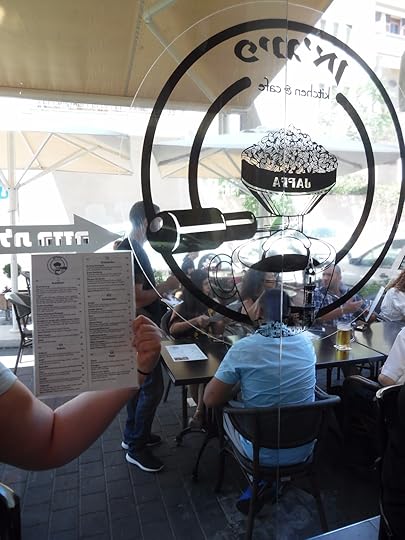 After getting ourselves up and around we ate breakfast at Finnegan Kitchen & Cafe near our apartment. We had Aig’h, an Arabic omelet with herbs, cauliflower, onion, eggplant and roasted peppers served alongside bread, cream cheese, feta cheese, tuna salad, olives, tahini, jam and butter. We also had Shakshuka and coffee. While we were at breakfast Sarah finished the videos from the Tel Gezer dig and began to upload them. The videos are available here and here.
After getting ourselves up and around we ate breakfast at Finnegan Kitchen & Cafe near our apartment. We had Aig’h, an Arabic omelet with herbs, cauliflower, onion, eggplant and roasted peppers served alongside bread, cream cheese, feta cheese, tuna salad, olives, tahini, jam and butter. We also had Shakshuka and coffee. While we were at breakfast Sarah finished the videos from the Tel Gezer dig and began to upload them. The videos are available here and here.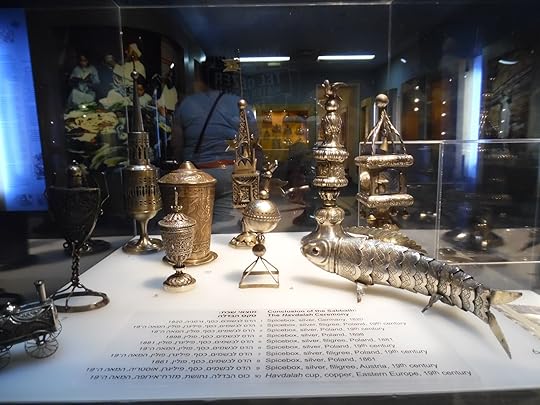 After breakfast we went to the Eretz Israel Museum which is on the campus of Tel-Aviv University. The museum has many exhibits of the land including an archeological dig from Tel Qasile, Mosaics from the 6th and 8th centuries, a museum of ethnography which holds exhibits on Jewish holidays and the Rothschild Center, a museum dedicated to the efforts of Baron Rothschild to settle the land. We saw a special exhibit on the Bar Kochba rebellion and how it inspired future strength of the Jewish people.
After breakfast we went to the Eretz Israel Museum which is on the campus of Tel-Aviv University. The museum has many exhibits of the land including an archeological dig from Tel Qasile, Mosaics from the 6th and 8th centuries, a museum of ethnography which holds exhibits on Jewish holidays and the Rothschild Center, a museum dedicated to the efforts of Baron Rothschild to settle the land. We saw a special exhibit on the Bar Kochba rebellion and how it inspired future strength of the Jewish people.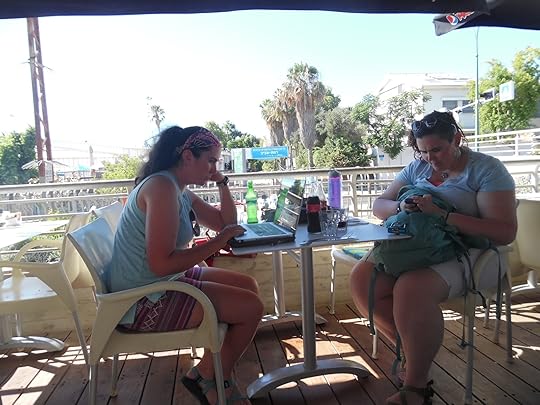 We stopped for lunch at the Italian cafe at Eretz Israel Museum. We ate pizza (which is Mediterranean, but not necessarily Jewish … but it was in Israel in Jewish surroundings).
We stopped for lunch at the Italian cafe at Eretz Israel Museum. We ate pizza (which is Mediterranean, but not necessarily Jewish … but it was in Israel in Jewish surroundings). 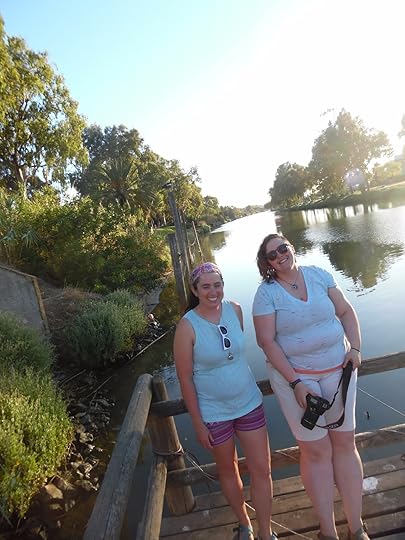 Afterwards we drove around Tel Aviv-University and the areas around the museum. We ended up at Yarkon Park. We took a walk in the park, enjoying the zoo, the river and people in the park. The park follows the Yarkon River from the western edge of the city to the sea. This park is like the Central Park of Tel-Aviv with multiple ball fields, an amusement park, and other amenities. We took some pictures along the river. Chelsea and Sarah laughed at how I was dressed, like an old Gezer waiting for people to talk to him. I told them the socks with a mountain and animals represented Mount Sinai, for this day is Shavuot in Israel, a holiday.
Afterwards we drove around Tel Aviv-University and the areas around the museum. We ended up at Yarkon Park. We took a walk in the park, enjoying the zoo, the river and people in the park. The park follows the Yarkon River from the western edge of the city to the sea. This park is like the Central Park of Tel-Aviv with multiple ball fields, an amusement park, and other amenities. We took some pictures along the river. Chelsea and Sarah laughed at how I was dressed, like an old Gezer waiting for people to talk to him. I told them the socks with a mountain and animals represented Mount Sinai, for this day is Shavuot in Israel, a holiday.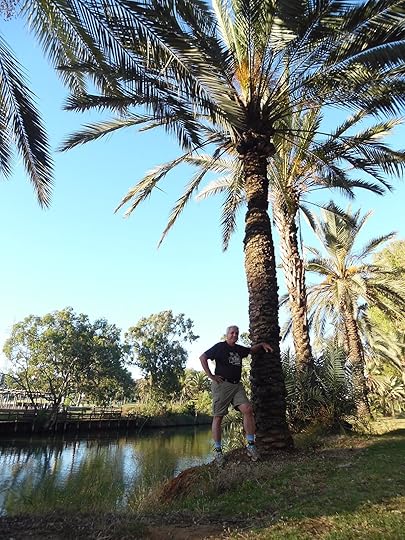 Following our walk we drove downtown to see Independence Hall and passed the Haganah Museum, which we will see on Tuesday, when it is opened. We enjoyed walking along Rothschild Blvd., and stopped for a drink at…
Following our walk we drove downtown to see Independence Hall and passed the Haganah Museum, which we will see on Tuesday, when it is opened. We enjoyed walking along Rothschild Blvd., and stopped for a drink at…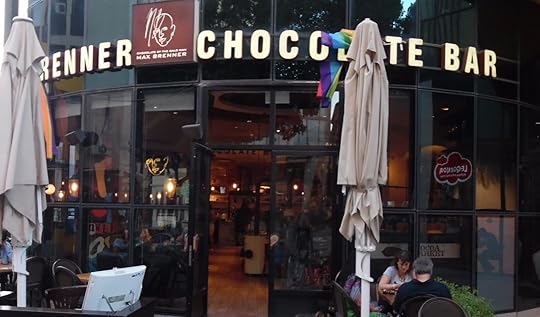
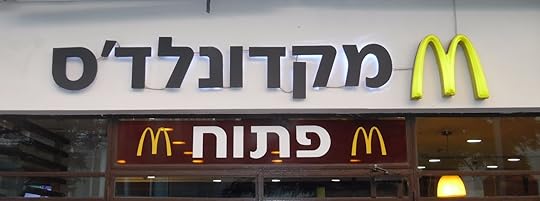
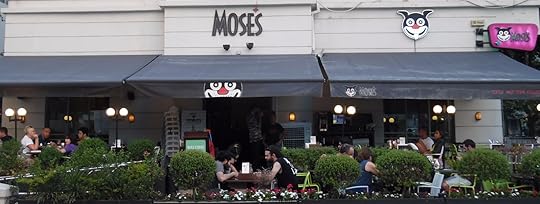 No, not there … at Aroma Coffee. The Israeli Coffee was a great end to our night. We might have to stop there again on Tuesday, when we return to the area.
No, not there … at Aroma Coffee. The Israeli Coffee was a great end to our night. We might have to stop there again on Tuesday, when we return to the area.
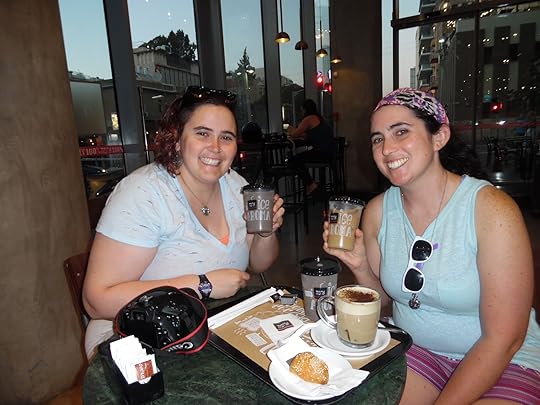
 After getting ourselves up and around we ate breakfast at Finnegan Kitchen & Cafe near our apartment. We had Aig’h, an Arabic omelet with herbs, cauliflower, onion, eggplant and roasted peppers served alongside bread, cream cheese, feta cheese, tuna salad, olives, tahini, jam and butter. We also had Shakshuka and coffee. While we were at breakfast Sarah finished the videos from the Tel Gezer dig and began to upload them. The videos are available here and here.
After getting ourselves up and around we ate breakfast at Finnegan Kitchen & Cafe near our apartment. We had Aig’h, an Arabic omelet with herbs, cauliflower, onion, eggplant and roasted peppers served alongside bread, cream cheese, feta cheese, tuna salad, olives, tahini, jam and butter. We also had Shakshuka and coffee. While we were at breakfast Sarah finished the videos from the Tel Gezer dig and began to upload them. The videos are available here and here. After breakfast we went to the Eretz Israel Museum which is on the campus of Tel-Aviv University. The museum has many exhibits of the land including an archeological dig from Tel Qasile, Mosaics from the 6th and 8th centuries, a museum of ethnography which holds exhibits on Jewish holidays and the Rothschild Center, a museum dedicated to the efforts of Baron Rothschild to settle the land. We saw a special exhibit on the Bar Kochba rebellion and how it inspired future strength of the Jewish people.
After breakfast we went to the Eretz Israel Museum which is on the campus of Tel-Aviv University. The museum has many exhibits of the land including an archeological dig from Tel Qasile, Mosaics from the 6th and 8th centuries, a museum of ethnography which holds exhibits on Jewish holidays and the Rothschild Center, a museum dedicated to the efforts of Baron Rothschild to settle the land. We saw a special exhibit on the Bar Kochba rebellion and how it inspired future strength of the Jewish people. We stopped for lunch at the Italian cafe at Eretz Israel Museum. We ate pizza (which is Mediterranean, but not necessarily Jewish … but it was in Israel in Jewish surroundings).
We stopped for lunch at the Italian cafe at Eretz Israel Museum. We ate pizza (which is Mediterranean, but not necessarily Jewish … but it was in Israel in Jewish surroundings).  Afterwards we drove around Tel Aviv-University and the areas around the museum. We ended up at Yarkon Park. We took a walk in the park, enjoying the zoo, the river and people in the park. The park follows the Yarkon River from the western edge of the city to the sea. This park is like the Central Park of Tel-Aviv with multiple ball fields, an amusement park, and other amenities. We took some pictures along the river. Chelsea and Sarah laughed at how I was dressed, like an old Gezer waiting for people to talk to him. I told them the socks with a mountain and animals represented Mount Sinai, for this day is Shavuot in Israel, a holiday.
Afterwards we drove around Tel Aviv-University and the areas around the museum. We ended up at Yarkon Park. We took a walk in the park, enjoying the zoo, the river and people in the park. The park follows the Yarkon River from the western edge of the city to the sea. This park is like the Central Park of Tel-Aviv with multiple ball fields, an amusement park, and other amenities. We took some pictures along the river. Chelsea and Sarah laughed at how I was dressed, like an old Gezer waiting for people to talk to him. I told them the socks with a mountain and animals represented Mount Sinai, for this day is Shavuot in Israel, a holiday. Following our walk we drove downtown to see Independence Hall and passed the Haganah Museum, which we will see on Tuesday, when it is opened. We enjoyed walking along Rothschild Blvd., and stopped for a drink at…
Following our walk we drove downtown to see Independence Hall and passed the Haganah Museum, which we will see on Tuesday, when it is opened. We enjoyed walking along Rothschild Blvd., and stopped for a drink at…

 No, not there … at Aroma Coffee. The Israeli Coffee was a great end to our night. We might have to stop there again on Tuesday, when we return to the area.
No, not there … at Aroma Coffee. The Israeli Coffee was a great end to our night. We might have to stop there again on Tuesday, when we return to the area.
Published on June 12, 2016 11:40
June 11, 2016
Israel Adventure - Day 3
After a good night’s sleep, we arose early to take Felipe, one of the students digging at Tel Gezer to the airport. While we were out we decided to visit Latrun Junction and other sites in the vicinity. After stopping at Mini Israel (they were closed, but we looked through the gate) we went to breakfast at Si, a coffee shop connected to a gas station at the junction. Chelsea & I ate avocado and egg sandwich, Sarah had a bagel with lox and Israeli Salad. The breakfast was great, and got us going for the day.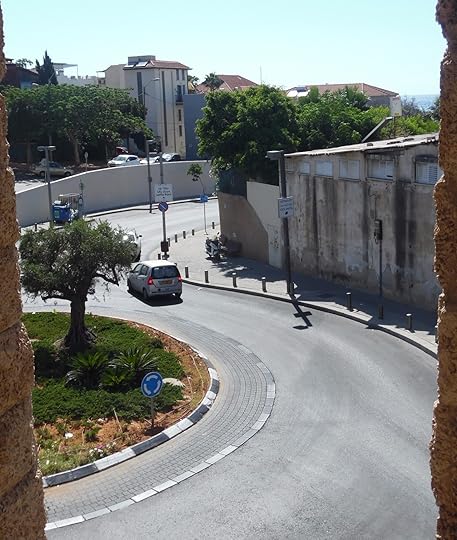 I asked some bike riders in the shop if they knew of an ancient synagogue found at Modi’in, and they directed us to the archeological findings of Emmaus. I took a picture through the front gate. This is the place Cleopas and his friend (Luke 24:13-35) were probably headed after Jesus was crucified. Emmaus is a resort at a hot spring. It is also the site of one of the battles (1 Macc. 4) of the Maccabees.
I asked some bike riders in the shop if they knew of an ancient synagogue found at Modi’in, and they directed us to the archeological findings of Emmaus. I took a picture through the front gate. This is the place Cleopas and his friend (Luke 24:13-35) were probably headed after Jesus was crucified. Emmaus is a resort at a hot spring. It is also the site of one of the battles (1 Macc. 4) of the Maccabees.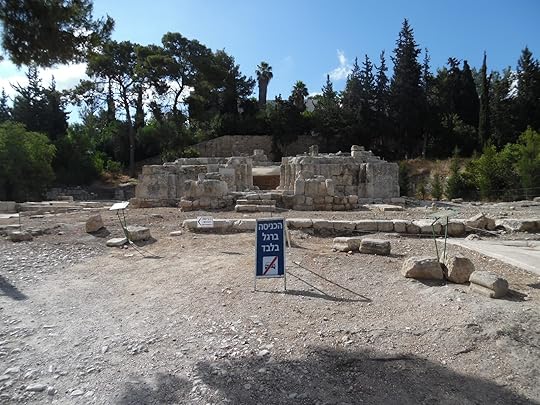 Just past Emmaus we entered Canada Park. The park is so named because Canadian Jews donated money to the Jewish National Fund to plant trees in this park. Again, we talked to some bike riders who directed us to the top of a hill for some panoramic views. We were well rewarded for following their directions. Attached you will find a photo from the scenic overlook toward Modi’in.
Just past Emmaus we entered Canada Park. The park is so named because Canadian Jews donated money to the Jewish National Fund to plant trees in this park. Again, we talked to some bike riders who directed us to the top of a hill for some panoramic views. We were well rewarded for following their directions. Attached you will find a photo from the scenic overlook toward Modi’in.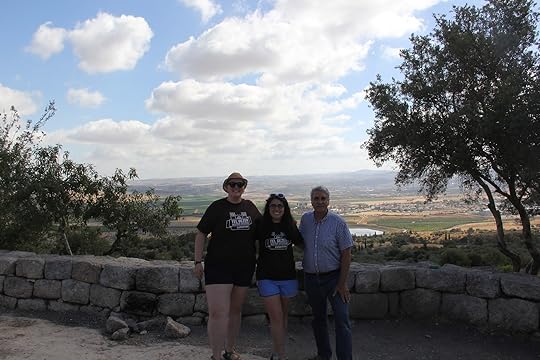 We continued up the road, and then took a trail at the top which led us to a Hasmonean Fortress. There are wine presses and cisterns in the ruins of the fortress. We took some pictures from the top in the direction of Gezer, where Sarah spent the last three weeks digging. (http://sjsimon.blogspot.co.il/)
We continued up the road, and then took a trail at the top which led us to a Hasmonean Fortress. There are wine presses and cisterns in the ruins of the fortress. We took some pictures from the top in the direction of Gezer, where Sarah spent the last three weeks digging. (http://sjsimon.blogspot.co.il/)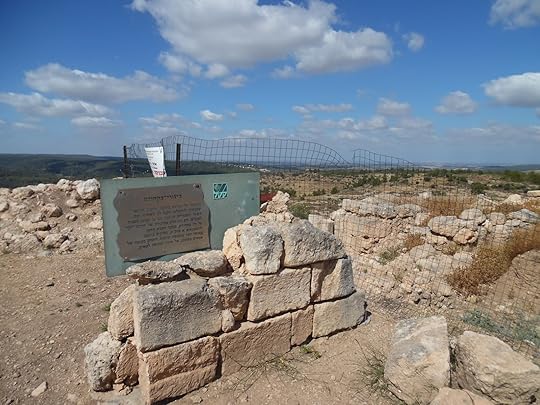 Coming back down the hill from Canada Park, we stopped at Latrun Junction again, where we got some water, and I walked up to the entrance of the Tank museum. This area was hotly contested during the 1948 war with Jordan. Remnants of the conflict started this museum.
Coming back down the hill from Canada Park, we stopped at Latrun Junction again, where we got some water, and I walked up to the entrance of the Tank museum. This area was hotly contested during the 1948 war with Jordan. Remnants of the conflict started this museum.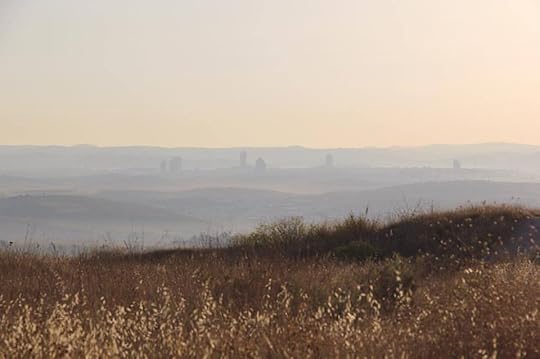 After leaving the museum we drove around a trappist monastery to Neve Shalom, where Sarah stayed the last three weeks. She gave us a tour, and showed us places where she took pictures.
After leaving the museum we drove around a trappist monastery to Neve Shalom, where Sarah stayed the last three weeks. She gave us a tour, and showed us places where she took pictures.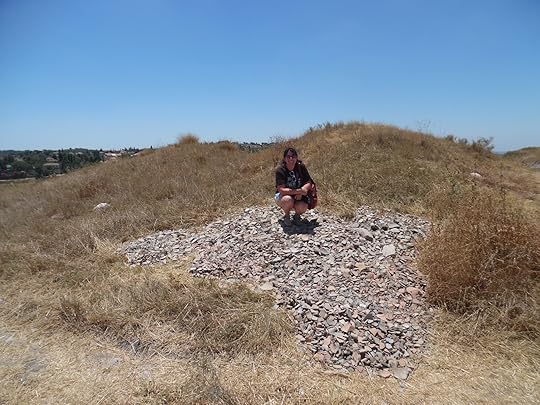 From Neve Shalom, we went to Tel Gezer, where Sarah was part of an archeological team from New Orleans Baptist Theological Seminary - http://nobtsarchaeology.blogspot.co.il/. We visited the Tunnel, Eli’s House and the Canaanite Gate, which Sarah (and Dr. Parker) detail on their blogs. We spent some time looking at this site.Then we came home. The GPS took us on a strange route through farms with grapes, peaches, harvested wheat, and other crops. It was interesting. We went through a small village, then to the main road. When we got home we took a nap.
From Neve Shalom, we went to Tel Gezer, where Sarah was part of an archeological team from New Orleans Baptist Theological Seminary - http://nobtsarchaeology.blogspot.co.il/. We visited the Tunnel, Eli’s House and the Canaanite Gate, which Sarah (and Dr. Parker) detail on their blogs. We spent some time looking at this site.Then we came home. The GPS took us on a strange route through farms with grapes, peaches, harvested wheat, and other crops. It was interesting. We went through a small village, then to the main road. When we got home we took a nap.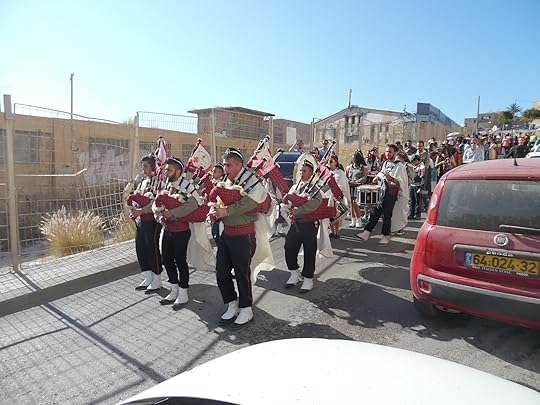 After our nap it was time to go to the beach. On the way we saw a Pentecost Parade put on by the Joppa Catholic Church. They had bagpipes and a band. The band played “When the Saints go Marching In.” Sarah felt as if she was in New Orleans.
After our nap it was time to go to the beach. On the way we saw a Pentecost Parade put on by the Joppa Catholic Church. They had bagpipes and a band. The band played “When the Saints go Marching In.” Sarah felt as if she was in New Orleans.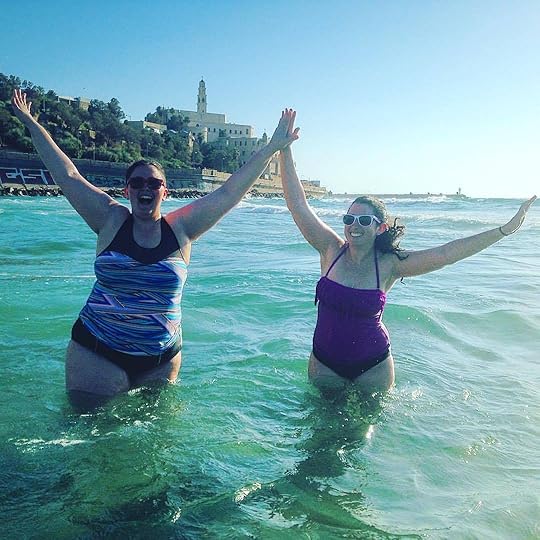 After the parade, we continued to the beach where we went swimming. The water was cool at first, but after being in it was great, for a warm day. The waves were choppy, but the water was fun. We swam for about an hour, then walked through old Joppa on the way home.
After the parade, we continued to the beach where we went swimming. The water was cool at first, but after being in it was great, for a warm day. The waves were choppy, but the water was fun. We swam for about an hour, then walked through old Joppa on the way home.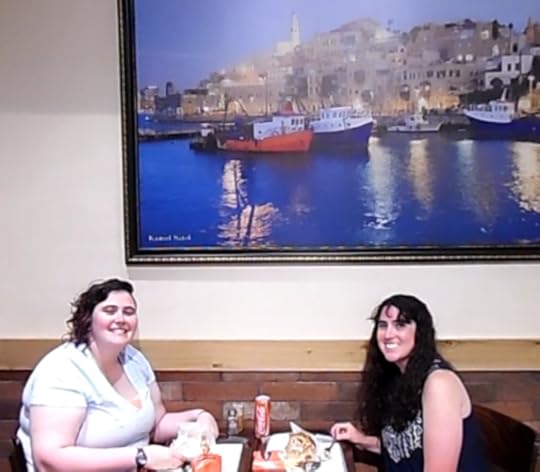 For dinner we went into the Florentine district and found a place that served Shawarma. The dinner was excellent, and the wait staff patient.
For dinner we went into the Florentine district and found a place that served Shawarma. The dinner was excellent, and the wait staff patient.
 I asked some bike riders in the shop if they knew of an ancient synagogue found at Modi’in, and they directed us to the archeological findings of Emmaus. I took a picture through the front gate. This is the place Cleopas and his friend (Luke 24:13-35) were probably headed after Jesus was crucified. Emmaus is a resort at a hot spring. It is also the site of one of the battles (1 Macc. 4) of the Maccabees.
I asked some bike riders in the shop if they knew of an ancient synagogue found at Modi’in, and they directed us to the archeological findings of Emmaus. I took a picture through the front gate. This is the place Cleopas and his friend (Luke 24:13-35) were probably headed after Jesus was crucified. Emmaus is a resort at a hot spring. It is also the site of one of the battles (1 Macc. 4) of the Maccabees. Just past Emmaus we entered Canada Park. The park is so named because Canadian Jews donated money to the Jewish National Fund to plant trees in this park. Again, we talked to some bike riders who directed us to the top of a hill for some panoramic views. We were well rewarded for following their directions. Attached you will find a photo from the scenic overlook toward Modi’in.
Just past Emmaus we entered Canada Park. The park is so named because Canadian Jews donated money to the Jewish National Fund to plant trees in this park. Again, we talked to some bike riders who directed us to the top of a hill for some panoramic views. We were well rewarded for following their directions. Attached you will find a photo from the scenic overlook toward Modi’in. We continued up the road, and then took a trail at the top which led us to a Hasmonean Fortress. There are wine presses and cisterns in the ruins of the fortress. We took some pictures from the top in the direction of Gezer, where Sarah spent the last three weeks digging. (http://sjsimon.blogspot.co.il/)
We continued up the road, and then took a trail at the top which led us to a Hasmonean Fortress. There are wine presses and cisterns in the ruins of the fortress. We took some pictures from the top in the direction of Gezer, where Sarah spent the last three weeks digging. (http://sjsimon.blogspot.co.il/) Coming back down the hill from Canada Park, we stopped at Latrun Junction again, where we got some water, and I walked up to the entrance of the Tank museum. This area was hotly contested during the 1948 war with Jordan. Remnants of the conflict started this museum.
Coming back down the hill from Canada Park, we stopped at Latrun Junction again, where we got some water, and I walked up to the entrance of the Tank museum. This area was hotly contested during the 1948 war with Jordan. Remnants of the conflict started this museum. After leaving the museum we drove around a trappist monastery to Neve Shalom, where Sarah stayed the last three weeks. She gave us a tour, and showed us places where she took pictures.
After leaving the museum we drove around a trappist monastery to Neve Shalom, where Sarah stayed the last three weeks. She gave us a tour, and showed us places where she took pictures. From Neve Shalom, we went to Tel Gezer, where Sarah was part of an archeological team from New Orleans Baptist Theological Seminary - http://nobtsarchaeology.blogspot.co.il/. We visited the Tunnel, Eli’s House and the Canaanite Gate, which Sarah (and Dr. Parker) detail on their blogs. We spent some time looking at this site.Then we came home. The GPS took us on a strange route through farms with grapes, peaches, harvested wheat, and other crops. It was interesting. We went through a small village, then to the main road. When we got home we took a nap.
From Neve Shalom, we went to Tel Gezer, where Sarah was part of an archeological team from New Orleans Baptist Theological Seminary - http://nobtsarchaeology.blogspot.co.il/. We visited the Tunnel, Eli’s House and the Canaanite Gate, which Sarah (and Dr. Parker) detail on their blogs. We spent some time looking at this site.Then we came home. The GPS took us on a strange route through farms with grapes, peaches, harvested wheat, and other crops. It was interesting. We went through a small village, then to the main road. When we got home we took a nap. After our nap it was time to go to the beach. On the way we saw a Pentecost Parade put on by the Joppa Catholic Church. They had bagpipes and a band. The band played “When the Saints go Marching In.” Sarah felt as if she was in New Orleans.
After our nap it was time to go to the beach. On the way we saw a Pentecost Parade put on by the Joppa Catholic Church. They had bagpipes and a band. The band played “When the Saints go Marching In.” Sarah felt as if she was in New Orleans. After the parade, we continued to the beach where we went swimming. The water was cool at first, but after being in it was great, for a warm day. The waves were choppy, but the water was fun. We swam for about an hour, then walked through old Joppa on the way home.
After the parade, we continued to the beach where we went swimming. The water was cool at first, but after being in it was great, for a warm day. The waves were choppy, but the water was fun. We swam for about an hour, then walked through old Joppa on the way home. For dinner we went into the Florentine district and found a place that served Shawarma. The dinner was excellent, and the wait staff patient.
For dinner we went into the Florentine district and found a place that served Shawarma. The dinner was excellent, and the wait staff patient.
Published on June 11, 2016 12:49
June 10, 2016
Israel Adventure - Day 2
Today was almost totally up in the air. Our day actually started in the evening at JFK Airport in New York City taking a six hour flight to Paris. People from all over the world flew with us. The third person in our row of seats was a man from Poland. We watched movies on the plane and tried to sleep some and ate two meals.As we flew I read some of Mark Twain’s Innocents Abroad. Samuel Clements travels to the Mediterranean by ship. He talks about a man who bought a new watch before taking the trip, and was totally frustrated with the time piece because once he left the United States it stopped working. Every three days it lost an hour (they crossed a time zone), and he couldn’t get the regulator to adjust for it. On our flight we lost an hour for every hour of flight. Six hours time change from New York to Paris, then one more as we flew to Israel.
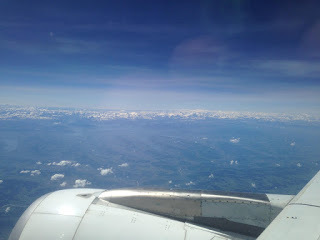 After checking through Paris we boarded our flight to Israel. We sat next to a man from Jerusalem. He told us of some interesting things in Israel. We ate a lunch of pita with mushrooms, Lox on English muffins, potato salad and cheesecake.
After checking through Paris we boarded our flight to Israel. We sat next to a man from Jerusalem. He told us of some interesting things in Israel. We ate a lunch of pita with mushrooms, Lox on English muffins, potato salad and cheesecake.
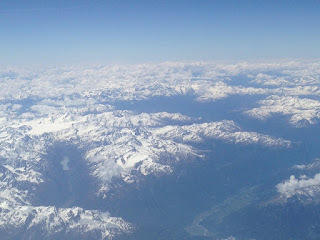 The flight was beautiful. We flew over the snow-capped, green-valleyed Alps. We were able to sleep on that flight also.
The flight was beautiful. We flew over the snow-capped, green-valleyed Alps. We were able to sleep on that flight also.
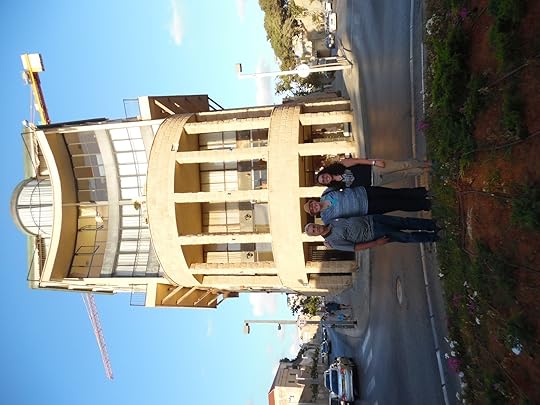
When we landed, we rented a car, and drove to our accommodations. Sarah was there, as was Philippe, one of the other people who worked at Tel-Gezer. (To see Sarah’s trip, visit http://sjsimon.blogspot.co.il/) We are staying about two blocks from old Joppa. The place we are staying is in the picture. After settling in we went to a Shabbat Dinner at the Jews for Jesus Rosen Center in Tel-Aviv. It was great! We met some new people and had great discussions.
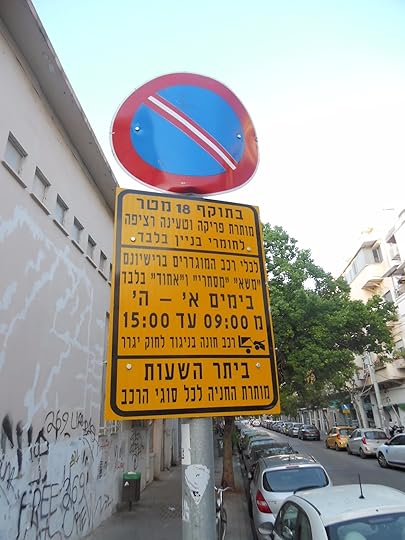
 After checking through Paris we boarded our flight to Israel. We sat next to a man from Jerusalem. He told us of some interesting things in Israel. We ate a lunch of pita with mushrooms, Lox on English muffins, potato salad and cheesecake.
After checking through Paris we boarded our flight to Israel. We sat next to a man from Jerusalem. He told us of some interesting things in Israel. We ate a lunch of pita with mushrooms, Lox on English muffins, potato salad and cheesecake. The flight was beautiful. We flew over the snow-capped, green-valleyed Alps. We were able to sleep on that flight also.
The flight was beautiful. We flew over the snow-capped, green-valleyed Alps. We were able to sleep on that flight also.
When we landed, we rented a car, and drove to our accommodations. Sarah was there, as was Philippe, one of the other people who worked at Tel-Gezer. (To see Sarah’s trip, visit http://sjsimon.blogspot.co.il/) We are staying about two blocks from old Joppa. The place we are staying is in the picture. After settling in we went to a Shabbat Dinner at the Jews for Jesus Rosen Center in Tel-Aviv. It was great! We met some new people and had great discussions.

Published on June 10, 2016 22:07
Israel Adventure - Day 1
The day has finally arrived. Chelsea and I are on our way to Israel. After an early morning trip to the airport and farewell to Denise, we were off to our adventure. First stop New York City. Travel time 1 hour 14 minutes (so they said, then they said we were arriving 25 minutes early!!) We took the train to Manhattan.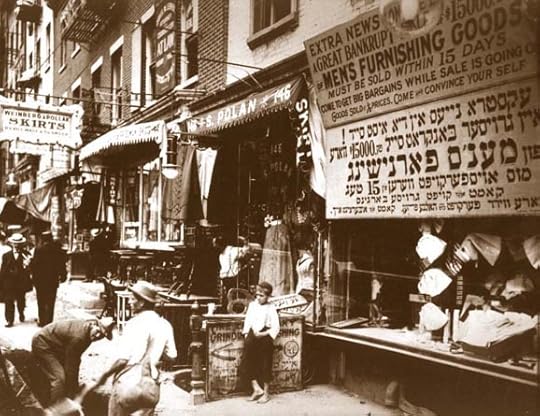 Breakfast was at Russ & Daughters on the Lower East Side. We met my cousin Jamie and nephew Benjamin for a plate of Lox (Nova, Scottish, Pastrami and Grave), Liverwurst, and the trimmings. I had Cucumber Soda, Chelsea had Pineapple, Jamie and Benjamin had Cherry. The food was FANTASTIC!!
Breakfast was at Russ & Daughters on the Lower East Side. We met my cousin Jamie and nephew Benjamin for a plate of Lox (Nova, Scottish, Pastrami and Grave), Liverwurst, and the trimmings. I had Cucumber Soda, Chelsea had Pineapple, Jamie and Benjamin had Cherry. The food was FANTASTIC!!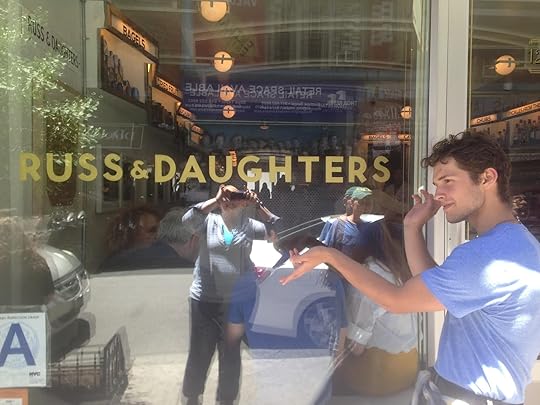 From there we went to the Lower East Side, Chinatown (for bubble tea and a red bean roll), and Little Italy. With a connection to be made we headed to Jamie’s house via Madison Square Park and Chelsea. On the way we gave our regards to Broadway at 5th Avenue.
From there we went to the Lower East Side, Chinatown (for bubble tea and a red bean roll), and Little Italy. With a connection to be made we headed to Jamie’s house via Madison Square Park and Chelsea. On the way we gave our regards to Broadway at 5th Avenue.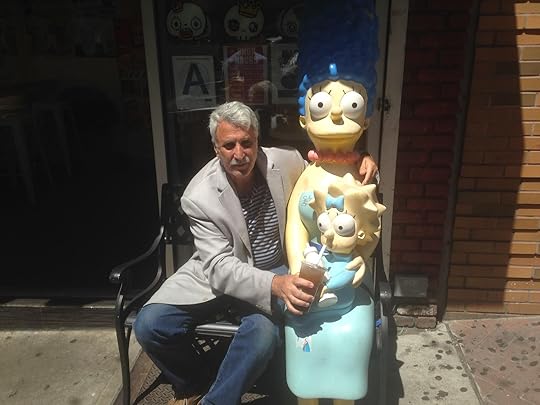 We made our way to JFK via the Long Island Railroad (first time I have taken them, the trip was very quick). On the airtrain we met a man leading a dig at Hebron (must be that season). As I write today’s post we are awaiting our flight to France, then to Israel.
We made our way to JFK via the Long Island Railroad (first time I have taken them, the trip was very quick). On the airtrain we met a man leading a dig at Hebron (must be that season). As I write today’s post we are awaiting our flight to France, then to Israel.
 Breakfast was at Russ & Daughters on the Lower East Side. We met my cousin Jamie and nephew Benjamin for a plate of Lox (Nova, Scottish, Pastrami and Grave), Liverwurst, and the trimmings. I had Cucumber Soda, Chelsea had Pineapple, Jamie and Benjamin had Cherry. The food was FANTASTIC!!
Breakfast was at Russ & Daughters on the Lower East Side. We met my cousin Jamie and nephew Benjamin for a plate of Lox (Nova, Scottish, Pastrami and Grave), Liverwurst, and the trimmings. I had Cucumber Soda, Chelsea had Pineapple, Jamie and Benjamin had Cherry. The food was FANTASTIC!! From there we went to the Lower East Side, Chinatown (for bubble tea and a red bean roll), and Little Italy. With a connection to be made we headed to Jamie’s house via Madison Square Park and Chelsea. On the way we gave our regards to Broadway at 5th Avenue.
From there we went to the Lower East Side, Chinatown (for bubble tea and a red bean roll), and Little Italy. With a connection to be made we headed to Jamie’s house via Madison Square Park and Chelsea. On the way we gave our regards to Broadway at 5th Avenue. We made our way to JFK via the Long Island Railroad (first time I have taken them, the trip was very quick). On the airtrain we met a man leading a dig at Hebron (must be that season). As I write today’s post we are awaiting our flight to France, then to Israel.
We made our way to JFK via the Long Island Railroad (first time I have taken them, the trip was very quick). On the airtrain we met a man leading a dig at Hebron (must be that season). As I write today’s post we are awaiting our flight to France, then to Israel.
Published on June 10, 2016 00:55
March 24, 2016
Who is Haman?
Every story needs a villain, and on a rare concurrence of days, we can talk about two stories and two villians. For Maundy Thursday (the traditional time of Jesus’ Last Supper) and Purim both fall on the same day.The first villain of the day is named Haman. He was an advisor to the king, and loved to sit at the right hand (place of power) of the king. He is called an Agagite, meaning a son of Agag, the king of Amalek. Amalek was the grandson of Esau. It is said Amalek bears a grudge against Israel because Jacob stole his birthright. Moses said, “the LORD will have war against Amalek from generation to generation.“The man named Judas Iscariot was the treasurer for Jesus and his disciples. He loved to sit at the right hand of Jesus. His last name indicates he is a resident of Kerioth-hezron, which is on the border of Edom (land of Esau).When Mordecai discovered Haman’s plot to kill the Jews, Esther fasted for three days before holding a banquet where she revealed the identity of Haman the Agagite and his plot. Through the banquet Esther saved the nation of Israel.Jesus identified Judas Iscariot and his plot at his last supper. When John asked Jesus for the identity of the betrayer, Jesus said it was the one with whom he dipped the bread. Following the dinner Judas betrayed Jesus, who was hung on a cross to die the next day. Jesus died to save all who would believe and call on His name. He was laid in the tomb for three days, and rose again.Both Hamen and Judas wicked wicked men. Haman was hung by the king on his own gallows. According to Matthew 27 5, Judas Iscariot hung himself on his own gallows.
Oh once there was a wicked wicked man,And Judas was his name, Sir.He would have murdered Jesus Christ,But he would not stay dead, Sir.
CHORUS:Oh today we'll merry merry beOh today we'll merry merry beOh today we'll merry merry beAnd nosh some Matzah now sir..
He told us on the Passover This meal would be his last, sirHis life would end upon the cross,Oh my how he did scare us.
CHORUS
And Jesus, as His life did end,We knew he had some chutzpahWe laid Him in an empty tomb,Cause that is what we do, sir."
CHORUS
He laid inside the grave all nightAnd through the whole next day, sir,And then on through the next night too,The corpse was in the grave, sir.
CHORUS
When Easter came on Sunday mornSome wanted to anoint Him,The stone would it be rolled away?Oh yes, so we can go in.
CHORUS
When we walked on inside the tomb,A big surprise we found sir,The body we saw wasn’t thereThe cloth was on the ground sir.
CHORUS
The Angels they did come and sayThis man, He did arise sir,The grave, just look, it’s empty see, His body did arise sir.
Oh once there was a wicked wicked man,And Judas was his name, Sir.He would have murdered Jesus Christ,But he would not stay dead, Sir.
CHORUS:Oh today we'll merry merry beOh today we'll merry merry beOh today we'll merry merry beAnd nosh some Matzah now sir..
He told us on the Passover This meal would be his last, sirHis life would end upon the cross,Oh my how he did scare us.
CHORUS
And Jesus, as His life did end,We knew he had some chutzpahWe laid Him in an empty tomb,Cause that is what we do, sir."
CHORUS
He laid inside the grave all nightAnd through the whole next day, sir,And then on through the next night too,The corpse was in the grave, sir.
CHORUS
When Easter came on Sunday mornSome wanted to anoint Him,The stone would it be rolled away?Oh yes, so we can go in.
CHORUS
When we walked on inside the tomb,A big surprise we found sir,The body we saw wasn’t thereThe cloth was on the ground sir.
CHORUS
The Angels they did come and sayThis man, He did arise sir,The grave, just look, it’s empty see, His body did arise sir.
Published on March 24, 2016 04:34
March 23, 2016
Who was Hadassah?
The heroine of the book of Esther is young lady who had a rough start. The details of her early years are untold. We know that before Hadassah was a teenager her parents had died and she was under the care of an uncle named Mordecai. Esther’s given Hebrew name was Hadassah, a name which comes from the sweet smell of the myrtle tree. This could indicate the sweetness of her demeanour which later gained her favor with Hegai and the King of Persia. Hardships in life either result in bitterness over the events of life, or a grace which comes by acceptance and overcoming of trials.Following the disposal of Vashti (which I wrote about yesterday), an opportunity opened which would result in a new status for Hadassah. When King Ahasuerus found the absence of his queen left him lonely, his advisors (illustrious, star, testimony, jasper, lofty, worthy and dignified) recommended the a beauty contest to find the new queen. This was acceptable to King Ahasuerus (who blindly accepted anything anyone presented in this story), and young women were gathered from each of the 127 provinces who could please the king and his young advisors with their beauty.Mordecai, who lived in Susa heard of the contest, and shared this with Hadassah, who was also known as Esther (or star). Mordecai knew this was his niece’s calling.Esther was accepted for the contest, and resided in the harem. Esther won favor with Hagai, the steward of the harem. He made sure she had the best of beauty treatments, and special foods. Although it was not revealed that Hadassah was Jewish, these were probably the same foods fed to Daniel (1:8-16)
On the night assigned Esther went in to the King, and found favor with him. She was chosen to replace Vashti, and served as queen of all Persia. … continued tomorrow!
On the night assigned Esther went in to the King, and found favor with him. She was chosen to replace Vashti, and served as queen of all Persia. … continued tomorrow!
Published on March 23, 2016 11:33
March 22, 2016
Who was Vashti?
Vashti was the queen of Persia, who was a beauty queen, for her name means beautiful. The king felt she was his companion, and was indeed proud of her. He gave her great freedom, and anything she desired.The King, named Ahasuerus was successful, vain and rich. He ruled over Persia at it’s height. Although he had not conquered all of the lands leading to his empire’s greatness, he still liked to brag about his military victories. In the third year of his reign he threw a six month long party. Nothing was off limits to his guests during the party. The king provided food, drinks and anything else desired to all of his invited guests. Through the endurance of the party Ahasuerus became more and more extravagant.At the end of the first week of the party, on the seventh day, Ahasuerus decided to show off the beauty of his wife. He sent his seven eunuchs to bring Vashti to the great hall. At this time the queen, who was hosting her own party and knew the king was in a drunken state refused to come.Ahasuerus had been stood up. He was embarrassed. He did not know what to do. (I am sure the king never considered how poor his request was in the first place, and certainly he, the most powerful monarch in the world, would not admit to a mistake, even if he had realized the error of the request or his judgment). He called his advisers (illustrious, star, testimony, jasper, lofty, worthy and dignified) to given him advice on what to do and how to overcome the great embarrassment which came from Vashti's refusal to show off her beauty in the midst of his party.The king’s advisers discussed the matter. To say the king made a mistake was off the table. To ignore the situation was a bad idea. To help the king see the situation from Vashti’s point of view would be unacceptable. The advisers realized the danger which would come if Vashti were ever allowed to share her side of the story. They must put Vashti away quickly, before here guests get wind of what just happened, and the queen’s reasoning for not appearing as a token at the king’s party. The advisers must delicately handle the situation and so the king’s political blunder would not be found out.The advisers talked through their options and decided to advise the king how the issue. They informed Ahasuerus that the problem went far beyond his personal embarrassment. They said, “If the women of the kingdom hear about the queen’s behavior, they will think they can do the same.” They told the king that wives throughout the kingdom will refuse to obey their husband’s orders and treat everything they with contempt. A resistance movement could start which would result in instability of home, and eventually the destabilize the entire kingdom. The only hope for Persia is to put Vashti away. The king must send her to the far reaches of his harem and never see her again.The king thought (but not very long, for he had a party to attend), and decided the advisors were correct. He must never see Vashti again. He must distance her further than the harem, and indeed throw her out of his household, and punish her, so all of the men, and the women of the kingdom would see this example of what would happen when a wife treated her husband with contempt.There has been much discussion on why Vashti would refuse the King’s orders, after all he was the most powerful monarch in the world at the time. Her very existence, and all of her prosperity depended on him. Some say she was vain and wicked. She decided to make her stand and put the king in the place. Others note how drunk the king was. They say that it would be to Vashti’s embarrassment if she did show up. She did not want to be a token, or a trophy (as the other things the king was showing off). Some say she is a role model for women everywhere, for women should not be placed in demeaning situations.
Was she wise, naive, or just plain stupid? The question comes, what would you do. There was not good solution. It was lose-lose for everyone, except for Esther (more on that tomorrow) and the Jews. And of course, the party went on. Five months and three weeks later, no one remembered the incident, or Vashti. They only felt sorry for the King, for he needed a wife.
Was she wise, naive, or just plain stupid? The question comes, what would you do. There was not good solution. It was lose-lose for everyone, except for Esther (more on that tomorrow) and the Jews. And of course, the party went on. Five months and three weeks later, no one remembered the incident, or Vashti. They only felt sorry for the King, for he needed a wife.
Published on March 22, 2016 12:12
March 19, 2016
Stories of Palm leaves & Victory
Today is a day of victory stories and celebrations with Palm leaves. We all know that Jesus rode into Jerusalem on a donkey amidst great celebration with people laying down palm branches and clothing to build up the road. Why do we have this tradition? There are stories, some of which have been forgotten. Having grown up in south Florida, palm branches are fun to wave and build outdoor structures (like lean-to's, pirate shacks, tree houses, picnic shelters, and Sukkot tabernacles). Palm leaves speak of vacations in warm places. Even in Israel the symbol of Jericho was the Palm Tree.Palm leaves are symbolic and have been used throughout history as emblems of joy and victory (Ps 92:12). They were engraved throughout the Temple, beginning on the basins at the entrance of the Temple. They are used during the Feast of Tabernacles to show God’s bounties. (Leviticus 23:40)The stories start with the triumphant entry when King David brought the ark of the covenant into Jerusalem. “David went and brought up the ark of God from the house of Obed-edom to the city of David with rejoicing.... And David danced before the Lord with all his might. And David was wearing a linen ephod. So David and all the house of Israel brought up the ark of the Lord with shouting and with the sound of the horn. (2 Sam 6:12-15)Likewise, there was great celebration when Jehu was anointed King by the prophet Elisha. “When Jehu came out to the servants of his master, they said to him,“Is all well? Why did this mad fellow come to you?” ... He spoke to me, saying, ‘Thus says the Lord, I anoint you king over Israel.’” Then in haste every man of them took his garment and put it under him on the bare steps, and they blew the trumpet and proclaimed, “Jehu is king.” (2 Kings 9:11-13)The Jews look forward to the time the Messiah will come into Jerusalem in the midst of great celebration. “Rejoice greatly, O daughter of Zion! Shout aloud, O daughter of Jerusalem! Behold, your king is coming to you; righteous and having salvation is he, humble and mounted on a donkey, on a colt, the foal of a donkey.” (Zech 9:9) “Go through, go through the gates, Clear the way for the people; Build up, build up the highway, Remove the stones, lift up a standard over the peoples. 11 Behold, the LORD has proclaimed to the end of the earth, Say to the daughter of Zion, "Lo, your salvation comes; Behold His reward is with Him, and His recompense before Him." (Isa 62:10-11)Stories of the Maccabees include palm leaves during two victorious marches into Jerusalem. The first was when Judas Maccabee celebrated the recapture of Jerusalem with dancing, singing and palm branches. “The Jews celebrated joyfully for eight days as on the Feast of Booths, remembering how, a little while before, they had spent the feast of Booths living like wild animals in the mountains and in caves. Carrying rods entwined with leaves, beautiful branches and palms, they sang hymns of grateful praise to him who had successfully brought about the purification of his own place. By public decree and vote they prescribed that the whole Jewish nation should celebrate these days every year.” (2 Macc 10:6-8) Twenty years later Jerusalem was under attack again, from Egypt, because of poor defenses. They appealed to their High Priest and Prince, Simon Maccabee for help. He rebuilt the defenses and the raids stopped. “There was a great celebration in the city because this terrible threat to the security of Israel had come to an end. Simon and his men entered the fort singing hymns of praise and thanksgiving, while carrying palm branches and playing harps, cymbals, and lyres. Simon issued a decree that the day should be joyfully celebrated every year.” (1 Macc. 13:51-2)
So it is against the background of many stories about victorious entries and palm leaves that Jesus enters Jerusalem. John tells us “The large crowd that had come to the feast heard that Jesus was coming to Jerusalem. So they took branches of palm trees and went out to meet him, crying out, ‘Hosanna! Blessed is he who comes in the name of the Lord, even the King of Israel!’” (12:12-13).Of course there are other stories also, like stories of donkeys ... but more on that later.
So it is against the background of many stories about victorious entries and palm leaves that Jesus enters Jerusalem. John tells us “The large crowd that had come to the feast heard that Jesus was coming to Jerusalem. So they took branches of palm trees and went out to meet him, crying out, ‘Hosanna! Blessed is he who comes in the name of the Lord, even the King of Israel!’” (12:12-13).Of course there are other stories also, like stories of donkeys ... but more on that later.
Published on March 19, 2016 18:03
March 17, 2016
Why Wear Green?
Green, I must wear green today. There will be lots of people wearing green, and if I do not wear green, I will get pinched. Look around, do you see people wearing green today? Are you wearing green today? Well, there used to be lots of people wearing green. What is it all about. When I poll people, most do not remember, and some do not know. Why do people wear green today? Is it because they like green? Maybe it’s because green is their color (people tell me green is my color all the time). Perhaps it is because green things are sprouting, so we wear green to celebrate spring. (In New Orleans people wear green early, along with yellow for daffodils and purple for redbuds … wrong!)When I poll people about why green is worn today I am surprised, many do not know. When I was young, everyone knew. It was part of our school. It was part of what went on at home. We all wore green on this day because if you forgot, someone would pinch you. Everyone knew it was because of St. Patrick’s Day. And we knew parts of the story.When I ask people where is their green they are surprised, and wonder why I ask. When I remind them it is St. Patrick’s day, most realize, and just say, “Oh.” (no exclamation point!) They know. They didn’t remember, but they did not forget. It doesn’t matter.Why St. Patrick’s Day? Some will say because we are celebrating some guy named St. Patrick, but they really don’t know who he is. In some places it is because people think it’s about green beer (was this Patrick guy a brewer? Or maybe it is just because the Irish like beer, and everyone, even those not Irish should join them.) Some say it is because of Shamrocks. They really don’t know the why of shamrocks, they just know shamrocks are part of it. Was it because Patrick was a gardener, and grew shamrocks? Did he wear shamrocks, or maybe sell shamrock pins? No, he told stories about shamrocks. But people have forgotten the story.Who was Patrick? A lucky leprechaun of Ireland? Or, was he like the Pied Piper of England … just he ridded the island of snakes (not children). If someone rid our country of snakes, we would celebrate!!We can look this all up on line, the point is, we have forgotten the story.Or maybe the story does not matter. We live in a busy world, and who has time to remember that today is March 17, and March 17 is St. Patrick’s Day, and we are supposed to wear green. We are individualists, and do our own thing, in this generation. We don’t need to wear green!But this is sad, for the stories teach us. They have passed down truths for generations. Do you know who St. Patrick is? The real St. Patrick … not the one who drinks beer (that is made up). St. Patrick is a hero. He told a story which saved Ireland. He really did chase a snake out of the country (Not many snakes, one snake) … What snake? The red snake. Read the story, think, and you will understand.
Published on March 17, 2016 03:46



